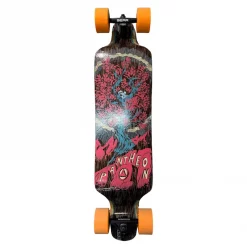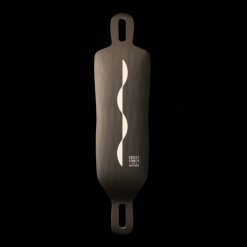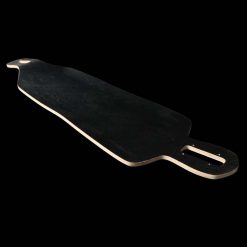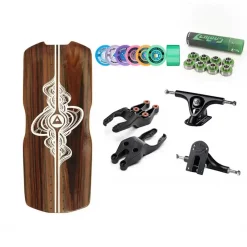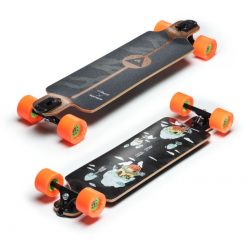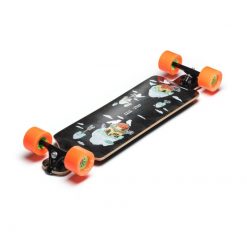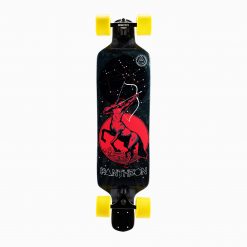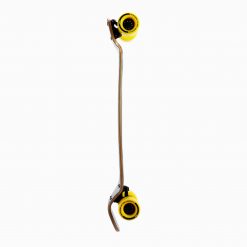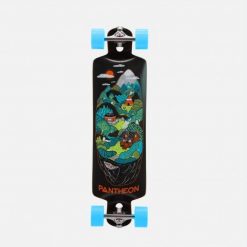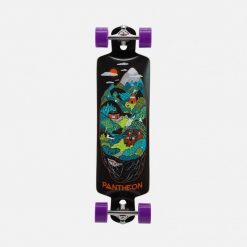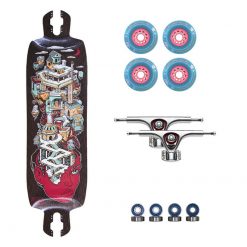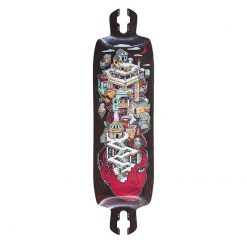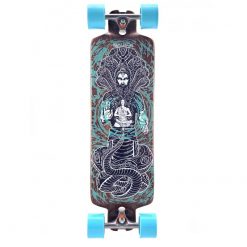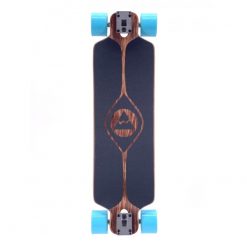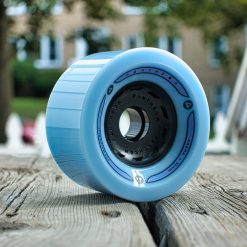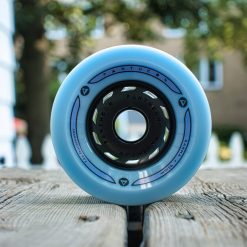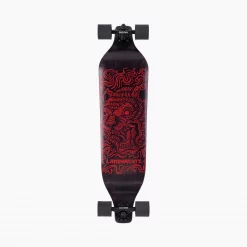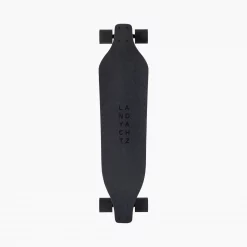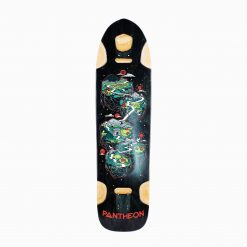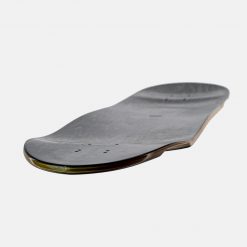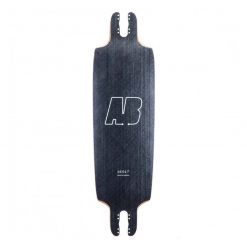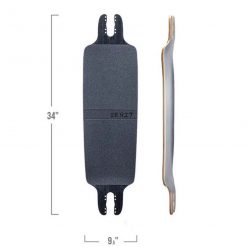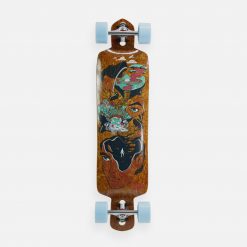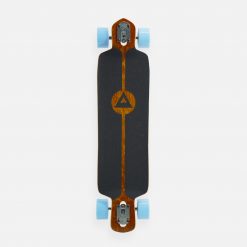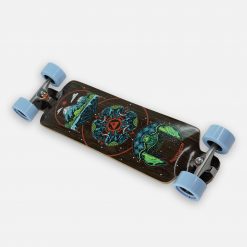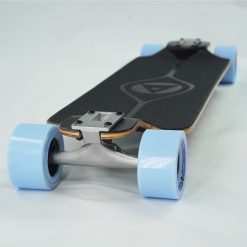Pantheon SuperDuperSonic ORANGATANG Wheels 36.5″ Longboard Complete
Longboard complete.
Fully assembled and ready to roll!
Ab: 459,90 €
incl. VAT
 Pantheon SuperDuperSonic ORANGATANG Wheels 36.5″ Longboard Complete
Pantheon SuperDuperSonic ORANGATANG Wheels 36.5″ Longboard Complete
The SuperDuperSonic is the next stepo in the evolution of our Supersonic model. If you’ve followed the evolution of our Supersonic model, you know this board has a legacy. It began as the Supersonic, and now… behold, the SuperDuperSonic. Call it the Supersonic, call it the Superduper—just make it yours. What matters is that this is the next-level version of Pantheons distance machine, and from here on out, all updates live right here.
So what makes it Super-DUPER?
Pantheon’s been refining this deck for years, and the SuperDuperSonic represents everything they’ve learned about making it faster, stronger, and more versatile.
Wheel Wells + Width Update
Pantheon always knew the Supersonic could benefit from deeper truck articulation, but carving wheel wells alone would have weakened the deck. Instead, they widened the neck and tail to keep flex balanced and add strength—then added carefully tuned wheel wells for more clearance. The result? More lean, less wheelbite, and more freedom when dialing in your setup. Light and medium flexes now match the heavy flex in width, giving all riders extra turning leverage.
Reinforced Neck for Durability
Both the front and rear necks are thicker and stiffer, strengthening the highest-stress zones of the board. That means more confidence, more life in your deck, and more miles under your feet.
Smarter Construction
They eliminated the weak link that plagues most skateboards: cross-ply maple. On light and medium flexes, they replaced it with fiberglass; on the stiffest flex, they swapped in long-ply maple. The SuperDuperSonic keeps its energy, resists fatigue, and shrugs off the leverage stress from its signature curves.
New Graphic by Rafa Alvarez
A new shape deserves a new look. Rafa Alvarez brings the SuperDuperSonic to life with a vibrant design: a towering tree rooted in a mountain landscape, sheltering a small squirrel within its branches. A reminder that, like Mother Nature, this board both empowers and protects.
For those who already understand this type of LDP board, let’s just get a couple key features out of the way that distinguish this board from any other deck of this type made before. Firstly, it has been designed around our most classic and readily available RKP cast trucks available. The intention here is to offer a super high functioning but cost effective setup.
The inherent geometry of the SuperDuperSonic LDP longboard will allow you to run Bear 130mm, 155mm or Paris 150mm effectively. You’ll want either the 40 degree (Bear) or 43 degree (Paris) in back, and either the 50 or the 40/43 in front. Because of the very similar base geometry of these trucks, they will run within about 1.5mm axle height from front to back regardless of which truck position you use, WITHOUT RISER and huge wheels like the Pantheon Karma 92mm.
Any further tinkering is certainly welcome, but this is an incredible starting point for a top of the line LDP longboard setup, with the stock setups already being super effective right out of the box.
The deck features a mild camber between the drops and incredibly tight curvature, considering the required curves necessary to make this geometry work. And they integrated very mild versions of Pantheons beloved crescent drops in all curvature points (even the down-curve of the de-wedged back end!) on this deck, making them stronger than boards of the past and allowing us to control where the board flexes. Our concave is mellow, as it should be, so that you’re comfortable no matter what distance you’re skating. But the curves are subtle and strong, and there are no true flat spots on the board anywhere, resulting in superb board feel.
SuperDuperSonic LDP Longboard Design Explained
For LDP riders looking to pump, a classic wedge front, de-wedge rear setup is a must. You want high degree turning in front and a nice low degree solid back end to throw your weight off of and create power. For the Supersonic, the built-in angles provide a ton of riding options. Riders will have a blast dialing in this setup and even changing it around for different riding styles.
The front of the Supersonic mounts at a positive 15 degrees. That means that a Bear or Paris 50 degree truck will run at 65 degrees. A quite high starting place for sure, but a high degree front with soft bushings will pump super easily. It will also result in a more front-weighted pump on your LDP longboard. This is ideal if the P stands for pushing AND pumping, especially. If you’re looking to dial it down a little, a truck in the 40-45 degree range will be a little more forgiving for all-out pushing speeds, while still netting a high angle around 55-60 degrees for efficient pumping.
The rear of the Supersonic is where even more options come into play. There are two mounting options. Mounting is available on the high, 40-degree angled wedge or on the far rear -17 degree angled tail. The -17 degree rear is obvious enough. We will typically use a lower degree cast truck in this position—either a Paris 43 or a Bear 40. The wedged 40 degree rear is actually designed for a FLIPPED rear truck, netting zero or near zero degrees in the back. The zero degree rear option is incredibly stable for high speed pushing. It is also effective for top-end speeds in pumping, although more effort will be required than when using the conventional -17 degree rear.
Setup for you SuperDuperSonic
We are offering four truck options for our Supersonic. The deck has been designed specifically with Bear Trucks or Paris Trucks in mind. You can certainly use whatever setup you want to your liking. Setting up outside of our recommended setups may require risers or angled risers. This will depend on your truck choice and the angles of your baseplate. You’ll want to consider your wheel choice in correspondence with your trucks to keep your setup from getting bite.
Our stock setups with 50 degree fronts are your safest choice. With the 50 degree front (Paris or Bear), you cannot get bite between our 92mm Karma wheels or other big wheels like 90mm Seismic Megawatts, Orangatang Bees Knees or Boa Hatchlings. This is as long as you have a stock cupped washer in the board-side position of your bushings. Once you start bringing down that front degree, wheelbite can start coming into play for the larger wheel option. This can be easily mitigated with risers and/or bushing and washer modifications.
With loads of plush pollinated urethane, a centerset core, and big ol’ round lips with chunk-resistant roundovers, the Bees Knees roll smooth, grip hard, and eat up rough roads. At just 10.1 oz per wheel, they’re light and quick: perfect for long-distance pushers, and anyone who treats curb-hopping like cardio. These adept 90mm honeycombs are here to smooth your stoke and take the sting out of rough rides.
The Caguamas on the other hand are a bit wider than the Bees Knees, which increases your grip. Due to a diametert of 85mm they bring your board lower to the ground which makes every push easier and lowers you point of gravity (more stability), while being big enough to basically roll over almost anything.
We recommend 50 degree front trucks for most riders using the Supersonic LDP longboard for long distance riding and pumping. This will push the pump power toward the front of the board and make pumping more effortless. Also 50° gives you more wheel clearance and makes it easier to learn how to pump.
For riders looking to max our their top speed, dropping the front angle may be considered. This can be combined with zeroing out the rear truck angle. Ultimately, between riding a 50 front or a 43/40 front for maximum pumping speed will come down to riding style. It is worth noting that a the lower degree front does feel a little more stable when pushing absolute maximum speed. Riders just looking to leisurely cover large distances will appreciate the efficiency of the higher degree front end.
Dieses Video wird von Youtube eingebettet. Durch das Apspielen des Videos gelten die Datenschutzerklärungen von Google.
Dieses Video wird von Youtube eingebettet. Durch das Apspielen des Videos gelten die Datenschutzerklärungen von Google.
| Brands | Pantheon Longboards |
|---|---|
| Flex | Heavy, Light, Medium |
| Trucks | Bear Gen 6 130mm 50° Front + 40° Back, Bear Gen 6 130mm 40° Front + 40° Back, Bear Gen 6 155mm 50° Front + 40° Back, Bear Gen 6 155mm 40° Front + 40° Back |
| Kugellager | Pantheon High Precision Bearings, Zealous Bearings, Zealous Ceramic Kugellager |
| Wheels | Orangatang Bees Knees 90mm 77A Blue, Orangatang Bees Knees 90mm 80A Orange, Orangatang Caguama 85mm 77A – Blue, Orangatang Caguama 85mm 80A – Orange |


